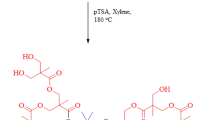Abstract
Hyperbranched poly(ester)s (HBPE) possess attributes for applications in a number of areas which include platforms for controlled release of actives and as rheology modifiers and coalescent agents in coatings. For the latter applications, properties such as the glass transition temperature and thermal stability are important. A number of HBPEs were produced with varying composition, molecular weight, degree of branching and end-group functionality in order to determine the effect of each on the HBPE thermal and rheological properties. These materials were synthesized from trimethylolpropane and the difunctional acids; adipic, phthalic and terephthalic. The chemical structure of the resulting HBPEs was fully characterized, particularly by SEC and NMR, and the thermal properties by DSC and TG. The glass transition temperature was found to depend primarily on HBPE composition and end-group functionality. The prominent feature of the thermal degradation for the hydroxyl-capped HBPE was dehydrative ether formation while that for carboxyl-capped polymers was decarboxylation.




Similar content being viewed by others
References
Yan D, Geo G, Frey H, editors. Hyperbranched polymers: synthesis, properties and applications. Hoboken: Wiley; 2011.
Li H, Cooper-White JJ, Kim I. Facile and controllable incorporation of gold nanoparticles within one-dimensional self-assemblies of hyperbranched polymers. Soft Matter. 2013;9:5270–6.
Kricheldorf HR, Zolotukin MG, Cardenas J. Non-stoichiometric polycondensations and the synthesis of high molar mass polycondensates. Macromol Rapid Commun. 2012;33:1814–32.
Zhang T, Howell BA, Dumitrascu A, Smith PB, Dvornic P. Thermal properties of hyperbranched poly(ester)s. In: Proceedings, 40th annual technical meeting of the North American thermal analysis society; 2012.
Zhou Z, Jia Z, Yan D. Theoretical investigation on the polyaddition of A2 and CB2 monomers with non-equal reactivity. Polymer. 2009;50:5608–12.
Zhang T, Howell BA, Dumitrascu A, Martin SJ, Smith PB. Synthesis and characterization of glycerol-adipic acid hyperbranched polyesters. Polymer. 2014;55:5065–72.
Min K, Gao H. New method to access hyperbranched polymers with uniform structure via one-pot polymerization of inimers in microemulsion. J Am Chem Soc. 2012;134:15680–3.
Jikei M, Suzuki M, Itoh K, Matsumoto K, Saito Y, Kawaguchi S. Synthesis of hyperbranched poly(L-lactide)s by self-polycondensation of AB2 macromonomers and their structural characterization by light scattering measurements. Macromolecules. 2012;45:8237–44.
Bao Y, He J, Li Y. Facile and efficient synthesis of hyperbranched polyesters based on renewable caster oil. Polym Int. 2012;62:1457–64.
Li Y, Cook WD, Moorhoff C, Huong W-C, Chen Q-Z. Synthesis, characterization and properties of biocompatible poly(glycerol sebacate) pre-polymer and gel. Polym Int. 2013;62:534–47.
Goodwin A, Baskaran D. Inimer mediated synthesis of hyperbranched polyglycerol via self-condensing ring-opening polymerization. Macromolecules. 2012;45:9657–65.
Ul-haq MI, Shenoi RA, Brooks DE, Kizhakkedathu JN. Solvent assisted anionic ring opening polymerization of glycidol: toward medium and high molecular weight hyperbranched polyglycerols. J Polym Sci Polym Chem. 2013;51:2614–21.
Zhang T, Howell BA, Martin PK, Martin SJ, Smith PB. Synthesis and NMR characterization of HBPEs from TMP and AA. In: Cheng HN, Gross RA, Smith PB, editors. Biocatalysis and biobased materials (ACS symposium series). Washington, DC: American Chemical Society; 2013.
Shi Y, Cao X, Luo S, Wang X, Graff RW, Hu D, Guo R, Gao H. Investigate the glass transition temperature of hyperbranched copolymers with segmented monomer sequence. Macromolecules. 2016;49:4416–22.
Wooley KL, Hawker CJ, Pochan JM, Frechet JMJ. Physical properties of dendritic macromolecules: a study of glass transition temperature. Macromolecules. 1993;26:1514–9.
Wooley KL, Frechet JMJ, Hawker CJ. Influence of shape on the reactivity and properties of dendritic, hyperbranched and linear aromatic polyesters. Polymer. 1994;35:4489–95.
Akabori K-I, Atarashi H, Ozawa M, Kondo T, Nagamura T, Tanaka K. Glass transition behavior of hyper-branched polystyrenes. Polymer. 2009;50:4868–75.
Kim YH, Beckerbauer R. Role of end groups on the glass transition of hyperbranched polyphenylene and triphenylbenzene derivatives. Macromolecules. 1994;27:1968–71.
Macosko CW, Rheology—principles, measurements, and applications. VCH Publishers, New York; 1994. Ch. 4, pp. 138–141, and Ch. 6, pp. 275–283.
Zhang T, Howell BA, Smith PB. Thermal degradation of trimethylolpropane/adipic acid hyperbranched poly(ester)s. J Therm Anal Calorim. 2014;116:1369–78.
Zhang T, Howell BA, Smith PB. Thermal degradation of carboxy-terminal trimethylolpropane/adipic acid hyperbranched poly(ester)s. J Therm Anal Calorim. 2015;122:1159–66.
Van Krevelen DW. Properties of polymers—their correlation with chemcial structure; their numerical estimation and prediction from additive group contributions. 3rd ed. Amsterdam: Elsevier; 1990.
Bicerano J. Prediction of polymer properties. 3rd ed. New York: Marcel Dekker; 2002.
Author information
Authors and Affiliations
Corresponding author
Rights and permissions
About this article
Cite this article
Dumitrascu, A., Sarkar, A., Chai, J. et al. Thermal properties of hyperbranched polyesters. J Therm Anal Calorim 131, 273–280 (2018). https://doi.org/10.1007/s10973-017-6408-z
Received:
Accepted:
Published:
Issue Date:
DOI: https://doi.org/10.1007/s10973-017-6408-z




